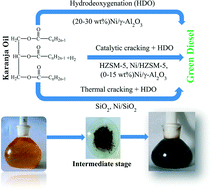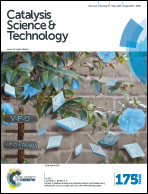Hydrodeoxygenation of karanja oil over supported nickel catalysts: influence of support and nickel loading†
Abstract
Production of hydrocarbon transportation fuels from triglycerides is extremely important to reduce dependency on limited fossil fuels. The present article provides a systematic examination of hydrodeoxygenation (HDO) of karanja oil (KO) in a semi-batch reactor over supported (γ-Al2O3, SiO2, and HZSM-5) nickel catalysts. The catalysts were associated with both dispersed and bulk nickel/nickel oxide depending on the extent of nickel loading and nature of the support. Virgin KO is composed of ~76 wt% C18 fatty acids with ~15 wt% oxygen. HDO of KO resulted in a wide range of alkanes (C10–C22) with n-heptadecane being the major one. Transformation of KO into alkanes proceeds through three distinct routes: HDO, catalytic cracking, thermal cracking, or their combination. Highly acidic catalysts (HZSM-5 and Ni/HZSM-5) promote catalytic cracking leading to formation of a large amount of lighter alkanes. The cracking reaction becomes significant over the γ-Al2O3 supported nickel catalyst with ≤15 wt% nickel loading at elevated temperatures. A strong metal–support interaction favored the HDO pathway over the γ-Al2O3 supported nickel catalyst with ≥20 wt% nickel loading. About 80 wt% of KO was converted to the liquid product with physicochemical properties comparable with light diesel oil.


 Please wait while we load your content...
Please wait while we load your content...